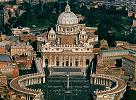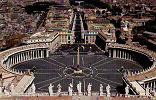St. Peter's Basilica & Its Art |
St. Peter's Basilica & Its Art |
|
Carlo Maderno St. Peter's Basilica 1606-12
Michelangelo
|
|


|
The greatest Baroque project was the completion of St. Peter's Basilica, built over the early Christian "Old" St. Peter's. Although the original 16th century design was a central plan, a long nave was added to make the church larger, therefore making the plan rectangular. An impressive facade was then added in front of the nave, which ruined the effect of Michelangelo's dome (his dome is over the original 16th century central plan, now the apse). In other words, one cannot see the dome except from a distance. The facade is not really Baroque, compared to the undulating facades of Bernini and Borromini. But the grandeur and immense size could be called Baroque elements. (Note the size of the people in relation to the architecture.) The enormous size of St. Peter's -- the largest church in the world -- was a way of emphasizing the importance of the Roman Catholic faith in the face of the Protestant reformers. |
|
Bernini St. Peter's Piazza begun 1656 |
|


|
This piazza plays an important role in Catholic ritual -- here the Pope gives the papal benediction on Easter Sunday and other special occasions. Bernini had to adjust the piazza to the existing buildings. He designed two vast colonnades like arms out from the facade which then form an oval (that popular baroque geometric form). Many call this configuration the "arms of the Church" welcoming and embracing the faithful. Brilliant propagandistic symbolism!
The design is also clearly baroque. Renaissance buildings tend to stand alone whereas baroque architecture relates to the environment and space. (Recall Bernini's Ecstasy of St. Teresa and its architectural setting.)
|
|
Bernini Baldacchino 1624-33
|
|


|
This structure is above the main altar (where St. Peter is buried) and located under the dome designed by Michelangelo. A baldacchino was a cloth canopy used in early Christian churches. Locating this form in such a dominant place was a way of asserting the traditions and history of the Roman Catholic church. Here, however, the baldacchino is in bronze, not cloth. To make it, tons of bronze were taken from the ceiling of the porch of the Roman Pantheon -- prompting the comment that "what wasn't done by the barbari [barbarians] was done by the Barberini." (Pope Urban VIII, who commissioned the work, was of the Barberini family; his family's heraldic symbols were the bee and the sun -- thus bees and suns are depicted on the spiral columns.) Note also the papal tiara, the orb, and the cross at the top of the baldacchino. This is another way of asserting the primacy of the Catholic church.
The spiral columns also have a religious and political meaning. Early Christian churches had used this kind of column and they were thought to have been used in Solomon's Temple. Reusing this column was another way of saying that the Catholic church is the true church, the original church. Recall that one characteristic of some baroque art is that it is a mixture of media. Would you call this almost 100-foot work a sculpture or architecture -- or both?! The baldacchino is the height of an eight-story building but it does fit the proportions of this huge church.
|
|
Bernini Cathedra Petri 1656-66
| |



|
The Cathedra Petri, or Chair of St. Peter's, is in the apse of St. Peter's. Like the baldacchino, it has an important function in the Counter-Reformation response to Protestantism. The church owned a significant relic--the original modest wooden chair of St. Peter. This relic was important to Catholicism because it could assert the papacy's claim of unbroken apostolic succession from St. Peter.
Bernini used the original chair as part of this architectural sculpture. The original chair is totally encased, surrounded by clouds, and almost levitates--as if hovering by Divine will. The figures in gilt bronze are Latin and Greek Fathers of the Church: Ambrose and Augustine; John Chrysostom and Athanasius. By depicting these early theologians of the church, Bernini again emphasizes the primacy of the Roman Catholic church. On the back of chair a relief depicts Christ's commission to St. Peter, who was the first Pope from the Catholic point of view. The Papal insignia--tiara and keys--emphasizes the tradition and history of the church. The dove above, the traditional symbol for the Holy Spirit, symbolizes God's blessing on the church.
|
| For more Counter-Reformation art (not in St. Peter's) click here. |
All images marked MAS were photographed on location by Mary Ann Sullivan. All other images were scanned from other sources or downloaded from the World Wide Web; they are posted on this password-protected site for educational purposes, at Bluffton College only, under the "fair use" clause of U.S. copyright law.